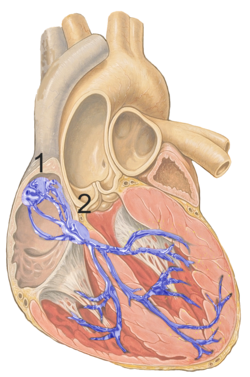Sinoatrial (SA) node
| Sinoatrial node | |
|---|---|

Figure 1 shows the conduction system of the heart. The SA node is labelled 1.
|
|
| Details | |
| System | Electrical conduction system of the heart |
| Artery | Sinoatrial nodal artery |
| Identifiers | |
| Latin | nodus sinuatrialis |
| Acronym(s) | SAN; SA node |
| MeSH | A07.541.409.819 |
| Dorlands /Elsevier |
12577255 |
| TA | A12.1.06.003 |
| FMA | 9477 |
|
Anatomical terminology
[]
|
|
The sinoatrial node (SAN; also known as sinus node) is a group of cells located in the wall of the right atrium of the heart. These cells have the ability to spontaneously produce an electrical impulse (action potential; see below for more details), that travels through the heart via the electrical conduction system (see figure 1) causing it to contract. In a healthy heart, the SAN continuously produces action potential, setting the rhythm of the heart and so is known as the heart's natural pacemaker. The rate of action potential production (and therefore the heart rate) is influenced by nerves that supply it.
The sinoatrial node is a banana-shaped structure that varies in size, usually between 10-30 millimeters (mm) long, 5–7 mm wide, and 1–2 mm deep (1 millimeter = 0.001 meters).
The SAN is located in the wall (myocardium) of the right atrium, laterally to the entrance of the superior vena cava in a region called the sinus venarum (hence + ). It is positioned roughly between a groove called the crista terminalis located on the internal surface of the heart and the corresponding sulcus terminalis, on the external surface. These grooves run between the entrance of the superior vena cava and the inferior vena cava
The cells of the SAN are spread out within a mesh of connective tissue, containing nerves, blood vessels, collagen and fat. Immediately surrounding the SAN cells, are paranodal cells. These cells have structures intermediate between that of the SAN cells and the rest of the atrium. The connective tissue, along with the paranodal cells insulate the SAN from the rest of the atrium preventing the electrical activity of the atrial cells from affecting the SAN cells. The SAN cells are smaller and paler than the surrounding atrial cells, with the average cell being around 8micrometers in diameter, and 20-30 micrometers in length (1 micrometer= 0.000001 meter). Unlike the atrial cells, SAN cells contain fewer (the power plant of the cell), have fewer myofibers (contractile machinery of the cell) and a smaller sarcoplasmic reticulum (calcium store unit, that releases calcium for contraction). This means that the SAN cells are less equipped to contract, compared to the atrial and ventricular cells.
...
Wikipedia
